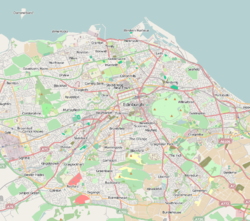Gilmore Place drill hall
| Gilmore Place drill hall | |
|---|---|
| Edinburgh, Scotland | |
 The frontage of the Gilmore Place drill hall | |
| Coordinates | 55°56′29″N 3°12′20″W / 55.94146°N 3.20562°W |
| Type | Drill hall |
| Site history | |
| Built | 1907 |
| Built for | War Office |
| In use | 1907 – late 1990s |
The Gilmore Place drill hall was a military installation in Edinburgh.
History
[edit]The drill hall was designed as the headquarters of the 4th Volunteer Battalion of the Royal Scots[1] by connecting several 19th century houses and adding a hall behind them in around 1907.[2] This unit became the 6th Battalion, Royal Scots, in 1908.[2] The battalion was mobilised at the drill hall in August 1914 before being deployed to Alexandria and then to the Western Front.[3] The 5th and 6th battalions, both heavily depleted, were amalgamated in July 1916, and spent the remainder of war on the Western Front as the 5/6th. After the war, the 6th Battalion remained in Belgium until January 1919 when it moved into Germany, and was reduced to a cadre in October 1919 and sent home to be disbanded.[4] After the war the battalion formed a battery in the 57th (Lowland) Medium Brigade, Royal Garrison Artillery based elsewhere in the city. The drill hall instead became the headquarters of 2 (Scottish) General Hospital and of 155 (Lowland) Field Ambulance.[5] These units evolved to become 50 (Scottish) Casualty Clearing Station in 1967 and that unit amalgamated with other units to form 205 (Scottish) General Hospital in 1967.[6]
After the Edinburgh detachment of 205 (Scottish) General Hospital moved out to the Granton Square drill hall in the late 1990s,[7] the Gilmore Place drill hall was decommissioned and, although the hall itself was demolished, the houses that formed the frontage of the property were returned to residential use.[2]
References
[edit]- ^ Grierson, Major-General J. M. (1909). "Records of the Scottish Volunteer Force 1859-1908". p. 185.
- ^ a b c "Edinburgh, 33, 35 Gilmore Place". Canmore. Retrieved 13 June 2017.
- ^ "The Royal Scots". The Long, Long Trail. Archived from the original on 20 May 2017. Retrieved 21 May 2017.
- ^ Paterson, Vol I, Appendix 5
- ^ "Royal Army Medical Corps". British Medical History. Retrieved 13 June 2017.[permanent dead link]
- ^ "History: 205 Field Hospital". Ministry of Defence. Archived from the original on 16 September 2017. Retrieved 14 June 2017.
- ^ "E Detachment". Ministry of Defence. Archived from the original on 16 September 2017. Retrieved 14 June 2017.
Sources
[edit]- Paterson, Robert H. (2000). Pontius Pilate's Bodyguard: a History of the First or the Royal Regiment of Foot. Edinburgh: The Royal Scots History Committee. ISBN 0-9540906-0-8.

